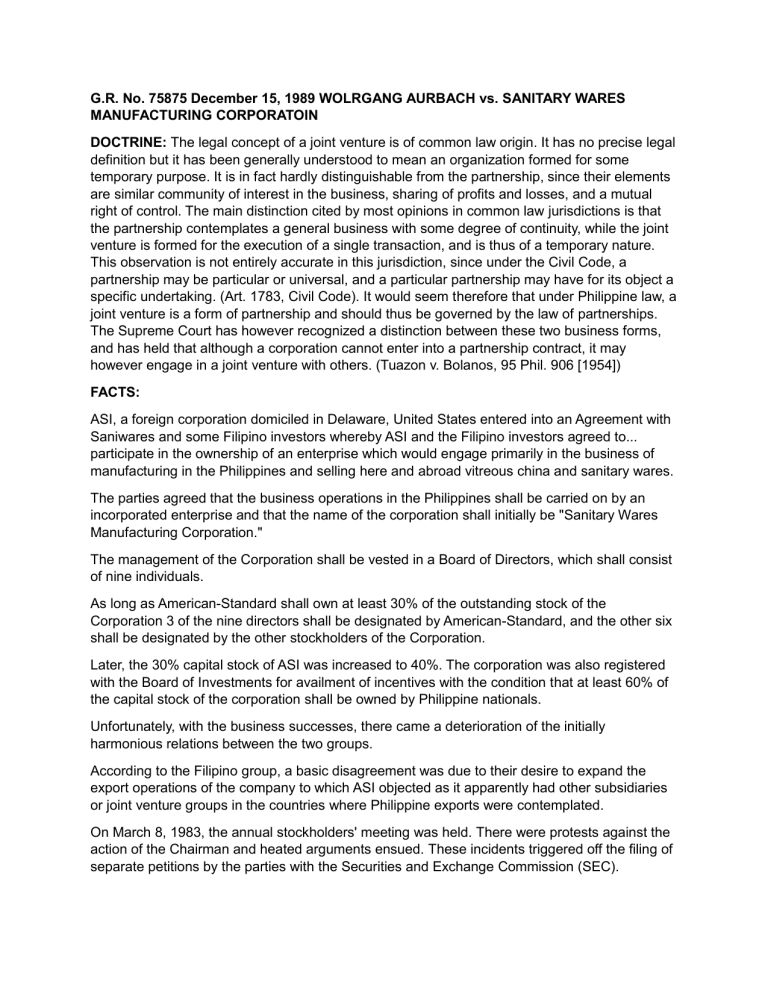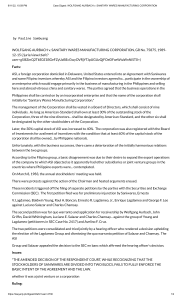
G.R. No. 75875 December 15, 1989 WOLRGANG AURBACH vs. SANITARY WARES MANUFACTURING CORPORATOIN DOCTRINE: The legal concept of a joint venture is of common law origin. It has no precise legal definition but it has been generally understood to mean an organization formed for some temporary purpose. It is in fact hardly distinguishable from the partnership, since their elements are similar community of interest in the business, sharing of profits and losses, and a mutual right of control. The main distinction cited by most opinions in common law jurisdictions is that the partnership contemplates a general business with some degree of continuity, while the joint venture is formed for the execution of a single transaction, and is thus of a temporary nature. This observation is not entirely accurate in this jurisdiction, since under the Civil Code, a partnership may be particular or universal, and a particular partnership may have for its object a specific undertaking. (Art. 1783, Civil Code). It would seem therefore that under Philippine law, a joint venture is a form of partnership and should thus be governed by the law of partnerships. The Supreme Court has however recognized a distinction between these two business forms, and has held that although a corporation cannot enter into a partnership contract, it may however engage in a joint venture with others. (Tuazon v. Bolanos, 95 Phil. 906 [1954]) FACTS: ASI, a foreign corporation domiciled in Delaware, United States entered into an Agreement with Saniwares and some Filipino investors whereby ASI and the Filipino investors agreed to... participate in the ownership of an enterprise which would engage primarily in the business of manufacturing in the Philippines and selling here and abroad vitreous china and sanitary wares. The parties agreed that the business operations in the Philippines shall be carried on by an incorporated enterprise and that the name of the corporation shall initially be "Sanitary Wares Manufacturing Corporation." The management of the Corporation shall be vested in a Board of Directors, which shall consist of nine individuals. As long as American-Standard shall own at least 30% of the outstanding stock of the Corporation 3 of the nine directors shall be designated by American-Standard, and the other six shall be designated by the other stockholders of the Corporation. Later, the 30% capital stock of ASI was increased to 40%. The corporation was also registered with the Board of Investments for availment of incentives with the condition that at least 60% of the capital stock of the corporation shall be owned by Philippine nationals. Unfortunately, with the business successes, there came a deterioration of the initially harmonious relations between the two groups. According to the Filipino group, a basic disagreement was due to their desire to expand the export operations of the company to which ASI objected as it apparently had other subsidiaries or joint venture groups in the countries where Philippine exports were contemplated. On March 8, 1983, the annual stockholders' meeting was held. There were protests against the action of the Chairman and heated arguments ensued. These incidents triggered off the filing of separate petitions by the parties with the Securities and Exchange Commission (SEC). The first petition filed was for preliminary injunction by Saniwares, Ernesto V. Lagdameo, Baldwin Young, Raul A. Boncan, Ernesto R. Lagdameo, Jr., Enrique Lagdameo and George F. Lee against Luciano Salazar and Charles Chamsay. The second petition was for quo warranto and application for receivership by Wolfgang Aurbach, John Griffin, David Whittingham, Luciano E. Salazar and Charles Chamsay... against the group of Young and Lagdameo (petitioners in SEC Case No. 2417) and Avelino F. Cruz. The two petitions were consolidated and tried jointly by a hearing officer who rendered a decision upholding the election of the Lagdameo Group and dismissing the quo warranto petition of Salazar and Chamsay. CA RULING i. the court of appeals, in effect, upheld the alleged election of private respondents as members of the board of directors of saniwares when in fact there was no election at all. ii. the court of appeals prohibits the stockholders from exercising their full voting rights represented by the number of shares in saniwares, thus depriving petitioners and the corporation they represent of their property rights without due process of law. iii. the court of appeals imposes conditions and reads provisions into the agreement of the parties which were not there, which action it cannot legally do. (p. 17, rollo-75875) The ASI Group and Salazar appealed the decision to the SEC en banc which affirmed the hearing officer's decision. Salazar Contentions: 11.1. That Amended Decision would sanction the CA's disregard of binding contractual agreements entered into by stockholders and the replacement of the conditions of such agreements with terms never contemplated by the stockholders but merely dictated by the CA . 11.2. The Amended decision would likewise sanction the deprivation of the property rights of stockholders without due process of law in order that a favored group of stockholders may be illegally benefitted and guaranteed a continuing monopoly of the control of a corporation. (pp. 14-15, Rollo-75975-76) ISSUE: Whether or not the nature of the business established by the parties was a joint venture or a corporation RULING: The rule is that whether the parties to a particular contract have thereby established among themselves a joint venture or some other relation depends upon their actual intention which is determined in accordance with the rules governing the interpretation and construction of contracts. While certain provisions of the Agreement would make it appear that the parties thereto disclaim being partners or joint venturers such disclaimer is directed at third parties and is not inconsistent with, and does not preclude, the existence of two distinct groups of stockholders in Saniwares one of which (the Philippine Investors) shall constitute the majority, and the other ASI shall constitute the minority stockholder. In any event, the evident intention of the Philippine Investors and ASI in entering into the Agreement is to enter into ajoint venture enterprise, and if some words in the Agreement appear to be contrary to the evident intention of the parties, the latter shall prevail over the former (Art. 1370, New Civil Code). The various stipulations of a contract shall be interpreted together attributing to the doubtful ones that sense which may result from all of them taken jointly (Art. 1374, New Civil Code). Moreover, in order to judge the intention of the contracting parties, their contemporaneous and subsequent acts shall be principally considered. (Art. 1371, New Civil Code). (Part I, Original Records, SEC Case No. 2417) In the instant cases, our examination of important provisions of the Agreement as well as the testimonial evidence presented by the Lagdameo and Young Group shows that the parties agreed to establish a joint venture and not a corporation. The history of the organization of Saniwares and the unusual arrangements which govern its policy making body are all consistent with a joint venture and not with an ordinary corporation. The legal concept of ajoint venture is of common law origin. It has no precise legal definition but it has been generally understood to mean an organization formed for some temporary purpose. (Gates v. Megargel, 266 Fed. 811 [1920]) It is in fact hardly distinguishable from the partnership, since their elements are similar community of interest in the business, sharing of profits and losses, and a mutual right of control. The main distinction cited by most opinions in common law jurisdictions is that the partnership contemplates a general business with some degree of continuity, while the joint venture is formed for the execution of a single transaction, and is thus of a temporary nature. … a joint venture is a form of partnership and should thus be governed by the law of partnerships. The Supreme Court has however recognized a distinction between these two business forms, and has held that although a corporation cannot enter into a partnership contract, it may however engage in a joint venture with others.



